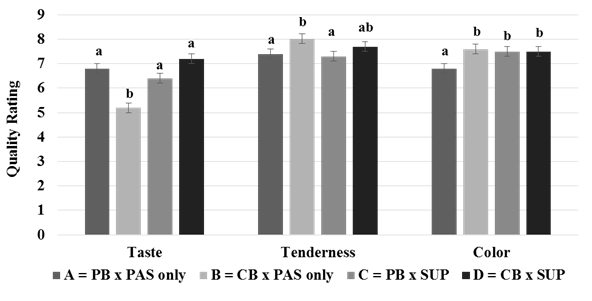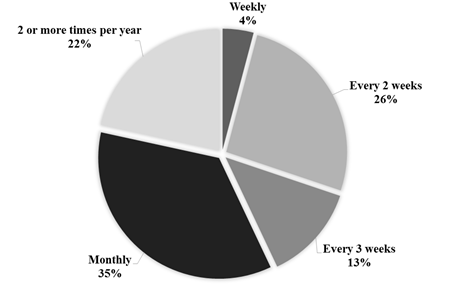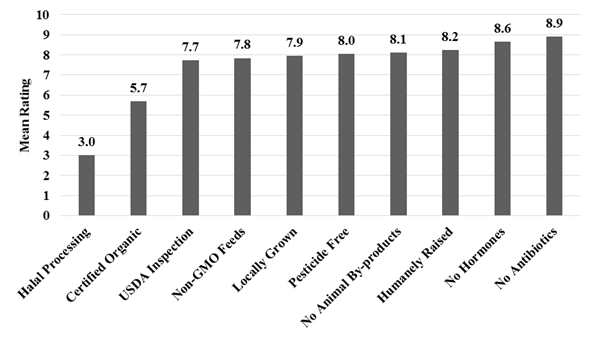 |
December 2017
|
December 2017 // Volume 55 // Number 6 // Research In Brief // v55-6rb2
Breed and Supplementation Influence on Consumer Ratings of Ground Meat from Pasture-Raised Lamb
Abstract
Consumer acceptance of pasture-raised hair sheep lamb was investigated. Food hub participants (n = 284) from Richmond, Virginia, were recruited to receive ground lamb and provide product quality ratings before and after product preparation. Over 96% of survey respondents specified that they would purchase local ground lamb if available, 35% indicated that they would purchase it at least once a month, and 43% indicated that they would pay a premium for it. Animal management pertaining to breed and supplementation had little effect on consumer ratings. The findings suggest that ground meat from hair sheep lambs could provide an opportunity to enhance profitability for small-scale producers in Virginia. Extension educators may be able to apply the findings in assisting sheep producers with lamb marketing.
Introduction
U.S. lamb consumption dwindled nearly 50% from 1.14 lb per person in 1995 to a mere 0.66 lb per person in 2015 (Organisation for Economic Co-operation and Development–Food and Agriculture Organization of the United Nations [OECD–FAO], 2016). Internationally, annual lamb consumption per person varies from 0 lb (Thailand) to 20.9 lb (Australia) (OECD–FAO, 2016). Moreover, international annual lamb consumption per person is minimal in comparison to that for poultry (61.5 lb), pork (49.6 lb), and beef and veal (30.2 lb), with lamb averaging 3.08 lb per person per year (OECD–FAO, 2016).
Clearly, lamb is not the meat of choice in the United States. Rather, U.S. consumers reach for poultry most often for their meals (Font-i-Furnols & Guerrero, 2014). Annual poultry consumption increased from 85.6 lb per person in 1995 to 105 lb per person in 2015 in the United States, where poultry is promoted as a healthful, easy-to-prepare meat (OECD–FAO, 2016). In 2010, promoting lamb meats as healthful, natural, and local was listed as a top marketing priority of the American Sheep Industry Association (Shiflett, Williams, & Rogers, 2010). In general, Americans are more familiar with how to prepare poultry than lamb and have confidence in successful meal preparation using poultry meats. A search for recipes on a top-rated food website yielded 22,104 poultry recipes (chicken, turkey, and duck), 7,531 beef recipes, and only 2,439 lamb recipes (Food Network, 2016). It makes sense, then, that unfamiliarity with lamb preparation and lack of available recipes may need to be addressed in future lamb industry promotions (Komar & Mickel, 2010).
Additionally, those in the sheep industry may need to explore different marketing options and markets. A comprehensive investigation of the U.S. sheep industry identified forage-finished lamb and direct marketing of high-quality, lighter weight lambs to expanding ethnic markets as key opportunities for improving efficiency and competitiveness within the industry (National Research Council, 2008). A report on the nontraditional lamb market in the United States, commissioned by the American Sheep Industry Association, echoed a similar sentiment and indicated that the greatest potential for sheep industry expansion lies primarily in the area of nontraditional markets and that alternative breeds, such as hair sheep, are well suited to serve these markets (Shiflett et al., 2010).
Opportunities in direct marketing are not limited to large-scale producers. In the past, small-scale-producer profitability in the sheep industry was challenged by economy of scale, and increases in product volume were achieved through the creation of lamb pools and cooperatives (Cross, Mills, & O'Connor, 1990). More recently, though, marketing studies have indicated that small-scale producers may improve profitability through direct marketing of value-added farm products (Bagdonis, Thomson, & Altemose, 2008; Curtis, Cowee, Havercamp, Morris, & Gatzke, 2008), especially meat products (Gwin & Lev, 2011). However, for sheep producers to direct market meat products successfully, there has to be both consumer acceptance of said products and willingness related to future purchases.
Therefore, to determine consumer acceptance of ground meat from pasture-raised lambs in Virginia, we conducted a market test of select consumers in the Richmond, Virginia, area to assess consumer interest in value-added lamb meat and to determine contributing factors leading to increased consumption. We also evaluated whether management strategies around supplementation and/or breed selection influenced consumer taste and quality perceptions related to lamb meat products.
Methods
We solicited survey participants from a 1,800-customer email list of a regional food hub/online farmers' market organization located in Richmond, Virginia. Our solicitation email garnered 284 responses from consumers willing to participate in the study.
We provided the 284 participants with a 1.0-lb package of ground lamb fabricated from hair sheep lambs raised in a grazing study at Virginia State University Randolph Research Farm. We used 23 purebred hair sheep (Barbados Blackbelly [BB], St. Croix [SC]) and 24 crossbred wool sheep (Dorset [D]) x hair (BB or SC) sheep 8-month-old lambs (D x BB and D x SC), balanced by sex, and hemi-castrated all ram lambs to facilitate cograzing with ewe lambs. Lambs grazed rotationally for 90 days during summer, predominantly on tall fescue (6.2%–12.4% crude protein [CP], 39.5%–50.2% acid detergent fiber [ADF], 52%–59% total digestible nutrients [TDN]). Lambs either grazed pasture only or received additional soy hull supplementation (9.4% CP, 48.5% ADF, and 54% TDN) at 2.0% of body weight (dry matter basis) at electronic feeding stations providing individual access to designated lambs. Following grazing, we harvested and processed all lambs through the use of standard procedures at a federally (U.S. Department of Agriculture [USDA]) inspected abattoir at Fort Valley State University in Georgia. We pooled lamb carcasses according to breed and production type and complete carcasses were deboned and processed as ground meat. We then labeled each ground meat package according to breed and production as follows:
- Package A = purebred lamb x pasture only (PB x PAS only)
- Package B = crossbred lamb x pasture only (CB x PAS only)
- Package C = purebred lamb x supplemented (PB x SUP)
- Package D = crossbred lamb x supplemented (CB x SUP)
The four breed-by-production types in the study had final live weights that were lighter than in traditional lamb markets and averaged as follows: A, 44.0 lb; B, 54.2 lb; C, 61.7 lb; and D, 78.7 lb. We randomly sent a 1.0-lb package of ground meat labeled A, B, C, or D to each participant, and participants were not made aware of the meaning of the letter label. Along with the ground lamb product, we provided a recipe, and asked participants to complete a survey that included evaluation of the raw product and the cooked product.
The survey instrument included close-ended questions and blank spaces where respondents could write additional comments. We asked participants to rate the product for selected qualitative characteristics (1 = extremely undesirable/dislike extremely/extremely bland, 9 = extremely desirable/like extremely/extremely intense), including ease of preparation, flavor, and overall quality. We also asked all participants to quantify the price range they would be willing to pay for the product and to estimate how often they would purchase the product. Additionally, we asked that they rate the importance of a series of marketing components, such as USDA certification, organic production, and humane treatment, and indicate how these factors would affect their purchasing decisions.
Dates of data collection were from November 2014 to January 2015. We analyzed responses through the use of PROC MEANS (means and confidence limits), PROC FREQ (chi-square analysis for yes/no responses), GLM (Tukey's multiple comparison test for determining interaction effects) and PROC NPAR1WAY (analysis of all ranking data) (SAS Institute, Cary, NC).
Results
Demographics
The initial response rate was 12% (284/1,800), and from those agreeing to participate, 74% (210/284) completed the survey. Select demographic information for the respondents is shown in Table 1. Among respondents, most (94%) had eaten lamb meat previously, and over half (58%) had prepared lamb meat at home prior to the study. Respondents were predominantly female (81%), and a majority (56%) were in the age range of 25 to 44 years. Additionally, over three quarters (79%) of the respondents were White, and a majority (54%) had an annual household income of greater than $100,000.
| Variable | No. | % |
| Eaten lamb previously | ||
| Yes | 198 | 94.3 |
| No | 12 | 5.7 |
| No response | 0 | 0 |
| Prepared lamb previously | ||
| Yes | 121 | 58.0 |
| No | 89 | 42.0 |
| No response | 0 | 0 |
| Sex | ||
| Female | 170 | 81.0 |
| Male | 24 | 11.4 |
| No response | 16 | 7.6 |
| Age | ||
| 20–24 | 4 | 1.9 |
| 25–34 | 57 | 27.1 |
| 35–44 | 60 | 28.6 |
| 45–54 | 45 | 21.4 |
| 55–64 | 26 | 12.4 |
| 65+ | 9 | 4.3 |
| No response | 9 | 4.3 |
| Annual income | ||
| <$20,000 | 1 | 0.5 |
| $20,000–$39,999 | 7 | 3.3 |
| $40,000–$59,999 | 19 | 9.0 |
| $60,000–$79,999 | 29 | 13.8 |
| $80,000–$99,999 | 23 | 11.0 |
| ≥$100,000 | 113 | 53.8 |
| No response | 18 | 8.6 |
| Cultural heritage | ||
| Caucasian (White) | 165 | 78.6 |
| Other | 34 | 16.2 |
| No response | 11 | 5.2 |
Before-Cooking Attributes
Participants' responses related to all before-cooking attributes were similar (p > .05) (Table 2), with the exception of before-cooking aroma, which was rated higher (p < .01) for ground meat from crossbred lambs (5.5 ± 1.5; 95% CL, 5.2–5.8) compared to that from purebred lambs (5.1 ± 1.5; 95% CL, 4.8–5.4).
| Before-cooking variable | M ± SD | 95% CL |
| Color | 7.4 ± 1.7 | 7.2–7.6 |
| Liking of color | 7.6 ± 1.2 | 7.4–7.8 |
| Aroma* | 5.3 ± 1.5 | 5.1–5.5 |
| Liking of aroma | 6.1 ± 1.6 | 5.9–6.4 |
| Texture | 6.9 ± 1.5 | 6.7–7.1 |
| Liking of texture | 7.0 ± 1.5 | 6.8–7.2 |
| Quality | 7.7 ± 1.7 | 7.5–7.9 |
| Liking of quality | 7.7 ± 1.2 | 7.5–7.8 |
|
Note. Data presented represents a compilation of the data for all type/supplementation options.
*p < .01. |
||
Ease-of-Preparation and After-Cooking Attributes
Participants' ratings of ease of preparation, aroma, texture, flavor, and juiciness were similar, regardless of breed type or supplementation (Table 3). However, after-cooking taste, tenderness, and color were all influenced by a breed-by-supplementation interaction effect (p < .04) (Figure 1). Respondents rated the color of cooked ground meat from A (PB x PAS only) lower than the color of cooked ground meat from all other production types tested. In addition, the mean ratings for tenderness indicated that respondents found cooked ground meat from B (CB x PAS only) to be more desirable than that from A (PB x PAS only) and C (CB x SUP), whereas D (PB x SUP) was intermediate (Figure 1). As for taste, consumers rated the taste of cooked ground meat from B (CB x PAS only) as less desirable than that from all other production types tested (Figure 1).
| Package labela |
Ease of preparation (M ± SD) |
Aroma (M ± SD) |
Texture (M ± SD) |
Flavor (M ± SD) |
Juiciness (M ± SD) |
| A | 7.9 ± 0.1 | 6.2 ± 0.2 | 7.4 ± 0.2 | 7.6 ± 0.2 | 6.8 ± 0.2 |
| B | 8.1 ± 0.1 | 6.7 ± 0.2 | 7.7 ± 0.2 | 7.7 ± 0.2 | 7.3 ± 0.2 |
| C | 7.9 ± 0.1 | 6.2 ± 0.2 | 7.6 ± 0.2 | 7.6 ± 0.2 | 7.7 ± 0.2 |
| D | 7.9 ± 0.1 | 6.5 ± 0.2 | 7.7 ± 0.2 | 7.7 ± 0.2 | 7.3 ± 0.2 |
| aA = purebred lamb x pasture only; B = crossbred lamb x pasture only; C = purebred lamb x supplemented; D = crossbred lamb x supplemented. | |||||
Figure 1.
Consumer Ratings of Selected Quality Characteristics of Cooked Ground Lamb Meat

Breed x supplement interaction effect p < .04
PB = purebred lamb; CB = crossbred lamb; PAS = pasture; SUP = supplemented
Additional Survey Questions
Ninety-six percent of respondents indicated that they would purchase local ground lamb if it were available. Thirty-five percent specified that they would make such purchases monthly (Figure 2), and 43% indicated that they would pay a premium price (>$6 per pound) for ground lamb meat.
Figure 2.
Consumers' Reported Frequencies of Willingness to Purchase Lamb Meat, if Available

Among respondents, interest also existed for fabricated ground lamb products, especially gyro loaf (60%), sausage links (46%), and burgers (41%). The top three production practices that would influence consumer purchasing decisions were (a) no use of antibiotics, (b) no use of hormones, and (c) humane treatment of animals (Figure 3).
Figure 3.
Production Practice Factors Influencing Respondents' Potential Purchase of Lamb Meat

USDA = U.S. Department of Agriculture; GMO = genetically modified organism
Discussion and Conclusion
According to the study findings, over 96% of survey respondents would purchase local ground lamb if it were available, 35% would purchase the product at least once per month, and 43% would pay a premium (>$6 per pound) for it. These are encouraging signs for the outlook of the U.S. sheep industry. It should be noted, however, that the majority of the participants (78%) were White (most likely not immigrants from countries consuming lamb) and that only 7% could be considered representatives from various ethnic groups (African, Middle Eastern, Asian, Latino). Although this distribution is representative of the state's demographics—that is, 70% White, 11% foreign born (U.S. Census Bureau, 2016)—most of the current demand for lamb meat in the United States comes from immigrants who originate from regions of the world where lamb is commonly consumed. One other important note is that the majority of participants (54%) had an annual household income exceeding $100,000. The median household income reported for Virginia for the 5-year period of 2011 to 2015 was approximately $65,000 (U.S. Census Bureau, 2016). The low representation of ethnic consumers and the higher annual household income reported by participants could have influenced some of the survey responses, especially the prices participants indicated they would be willing to pay for lamb products.
Despite the aforementioned limitations of the study, however, the findings are important because increased acceptance of fresh American lamb meat by all U.S. consumers may encourage sheep production and provide a profitable alternative for many small-scale producers. Findings from Bernues, Ripoll, and Panea (2012) suggested that seeking adventurous consumers, providing easy-to-prepare recipes, and including product labeling that identifies attributes related to pasture or grass feeding systems and local origin could promote higher sales potential. Findings from our study indicate that sheep producers who market directly to consumers may enhance sales by increasing customer awareness of specific production methods involving lack of hormone use, lack of antibiotic use, and humane treatment of animals.
Consumer acceptability of ground lamb meat appears favorable. Adaptation of ground lamb meat into valued-added products of gyro loaf, sausage links, and burgers may be a consideration for sheep producers looking to diversify their ground lamb product offerings. Innovative producers may create customer interest by developing add-on spice kits to create at-home versions of gyro loaf, sausages, and burgers. Consumer familiarity with diverse lamb cuts and knowledge of how to prepare different cuts may assist sheep producers in promoting additional sales to nonethnic audiences. Extension educators may assist sheep producers in lamb marketing by providing lamb cooking demonstrations, lamb-based cooking classes, healthful and easy-to-prepare lamb recipes, and educational materials directed to consumers searching for meat from local, pasture-raised lambs.
Acknowledgments
Our research was funded by the National Institute of Food and Agriculture, U.S. Department of Agriculture, Capacity Building Grant Program Award No. 2008-38814-04730. We would like to acknowledge Seasonal Roots, Richmond, Virginia, for assisting in data collection with their 2014 membership.
References
Bagdonis, J., Thomson, J. S., & Altemose, C. (2008). Extension's role in facilitating collaborative initiatives: Direct marketing farm products on the Internet. Journal of Extension, 46(2), Article 2IAW2. Available at: http://www.joe.org/joe/2008april/iw2.php
Bernues, A., Ripoll, G., & Panea, B. (2012). Consumer segmentation based on convenience orientation and attitudes toward quality attributes of lamb meat. Food Quality and Preference, 26, 211–220. doi:10.1016/j.foodqual.2012.04.008
Cross, T. L., Mills, R. R., & O'Connor, C. (1990). Pooling resources for small-producer profits. Journal of Extension, 28(3), Article 3FEA5. Available at: http://www.joe.org/joe/1990fall/a5.php
Curtis, K. R., Cowee, M. W., Havercamp, M., Morris, R., & Gatzke, H. (2008). Marketing local foods to gourmet restaurants: A multi-method assessment. Journal of Extension, 46(6), Article 6RIB2. Available at: http://www.joe.org/joe/2008december/rb2.php
Font-i-Furnols, M., & Guerrero, L. (2014). Consumer preference, behavior and perception about meat and meat products: An overview. Meat Science, 98, 361–371. doi:10.1016/j.meatsci.2014.06.025
Food Network. (2016). Recipe search. Retrieved from http://www.foodnetwork.com/
Gwin, L., & Lev, L. (2011). Meat and poultry buying at farmers markets: A survey of shoppers at the three markets in Oregon. Journal of Extension, 49(1), Article 1RIB4. Available at: http://www.joe.org/joe/2011february/rb4.php
Komar, S. J., & Mickel, R. (2010). Determining consumer acceptance of value-added meat goat products in New Jersey. Journal of the National Association of County Agricultural Agents, 3. Retrieved from http://www.nacaa.com/journal/index.php?jid=71
National Research Council. (2008). Changes in the sheep industry in the United States: Making the transition from tradition. Washington, DC: Academies Press.
Organisation for Economic Co-operation and Development–Food and Agriculture Organization of the United Nations. (2016). OECD-FAO agricultural outlook, meat consumption (indicator). Retrieved from https://data.oecd.org/agroutput/meat-consumption.htm
Shiflett, J. S., Williams, G., & Rogers, P. (2010). The nontraditional lamb market: Characteristics and marketing strategies. Agribusiness, Food, and Consumer Economics Research Center Commodity Market Research Report No. CM-02-10. Retrieved from http://afcerc.tamu.edu/publications/Publication-PDFs/CM-02-10%20Nontraditional%20Lamb%20Market%20Study-TCG2_FINAL.pdf
U.S. Census Bureau. (2016). Quick facts Virginia. Retrieved from https://www.census.gov/quickfacts/VA




